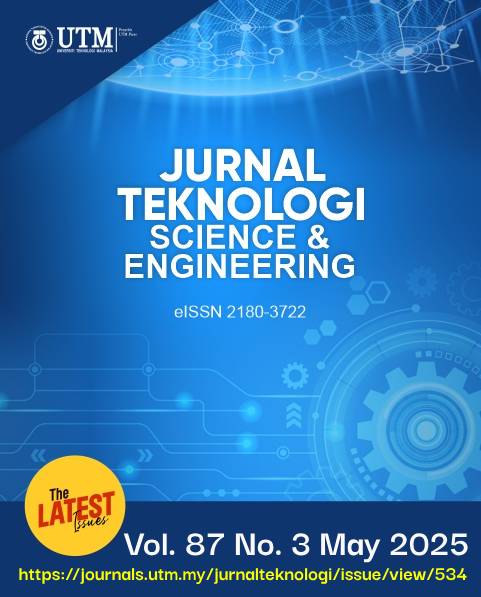PHOTOBIOMODULATION THERAPY REDUCES HYPOXIA-INDUCED LUNG INJURY IN SPRAGUE DAWLEY RATS UNDER HYPOBARIC CONDITIONS
DOI:
https://doi.org/10.11113/jurnalteknologi.v87.22857Keywords:
Lung hypoxia, hypobaric, photobiomodulation, 650 nm, histopathology, IL6Abstract
Hypoxia in hypobaric conditions refers to the reduced availability of oxygen due to decreased barometric pressure at high altitudes. As altitude increases, atmospheric pressure decreases, leading to a lower partial pressure of oxygen (PO2) and reduced oxygen saturation in blood and tissues. Photobiomodulation therapy (PBMT) has emerged as a potential adjunctive treatment for lung injury, offering non-invasive and promising benefits. PBMT has shown effectiveness in modulating inflammatory responses, reducing oxidative stress, promoting tissue repair, and improving respiratory function in conditions such as acute respiratory distress syndrome (ARDS), pneumonia, and pulmonary oedema. In this study, thirty 8-week-old male Sprague Dawley rats were divided into six groups: (i) normal control (Normal), no hypobaric exposure or treatment; (ii) negative control (Negative Control), hypobaric treatment without PBMT; (iii) one-week PBMT (PBMT1); (iv) two-week PBMT (PBMT2); (v) three-week PBMT (PBMT3); and (vi) four-week PBMT (PBMT4). Hypobaric exposure was performed weekly for 28 days at the Lakespra Facility (Indonesian Military Air Force, Jakarta, Indonesia) at an altitude of 25,000 feet for five minutes. PBMT was administered every two days with a stimulation energy dose of 0.4 Joule (2.037 J/cm²), totaling 8.15 J/cm² per day. The results indicated that PBMT significantly reduced a lung oedema index, lung injury severity, and expression of IL6, CD73, and adenosine, though it did not consistently reduce HIF-1 expression in lung tissue. In conclusion, PBMT effectively prevented lung injury induced by hypobaric hypoxia.
References
Ahmad, Y., Sharma, N. K., Ahmad, M. F. 2015. The Proteome of Hypobaric Induced Hypoxic Lung: Insights from Temporal Proteomic Profiling for Biomarker Discovery. Scientific Reports. 10681: 1–20. Doi: 10.1038/srep10681.
Suresh, M., Balijepalli S., Solanki., et al. 2023. Hypoxia-Inducible Factor 1α and Its Role in Lung Injury: Adaptive or Maladaptive. Inflammation. 46(2): 491–508.
Doi: 10.1007/s10753-022-01769-z.
Odenbach, J., Dhanoa, S., Sebastian, Milovanovic, L., et al. 2022. Acute Respiratory Distress Syndrome and Shunt Detection with Bubble Studies: A Systematic Review and Meta-Analysis. Crit Care Explor. 4(11): e0789.
Doi: 10.1097/CCE.0000000000000789.
Slobod, D., Damia, A., Leali, M., Spinelli, E., et al. 2023. Pathophysiology and Clinical Meaning of Ventilation-Perfusion Mismatch in the Acute Respiratory Distress Syndrome. Biology. 12(1): 67.
https://doi.org/10.3390/biology12010067.
Mancera-Soto, Chamorro-Acosta, Diana, M., Caballero, et al. 2022. Effect of Hypobaric Hypoxia on Hematological Parameters Related to Oxygen Transport, Blood Volume and Oxygen Consumption in Adolescent Endurance-training Athletes. Journal of Exercise Science & Fitness. 20(4): 391–399.
Savioli, G., ICeresa, I. F., Gori, G., Fumoso, F. et al. 2022. Pathophysiology and Therapy of High-altitude Sickness: Practical Approach in Emergency and Critical Care. J Clin Med. 11(14): 3937. Doi: 10.3390/jcm11143937.
Luks, A. M., Swenson, E. R., Bärtsch, P. 2017. Acute High-altitude Sickness. European Respiratory Review. 26: 160096. Doi: 10.1183/16000617.0096-201.
Hamblin, M. R. 2017. Mechanisms and Applications of the Anti-inflammatory Effects of Photobiomodulation. AIMS Biophys. 4(3): 337–361. Doi: 10.3934/biophy.2017.3.337.
Macedo, D. B., Roberta, C. T., Kido, H. W., Macedo, J. B., et al. 2022. Influence of Photobiomodulation Therapy on the Treatment of Pulmonary Inflammatory Conditions and Its Impact on COVID-19. Lasers Med Sci. 37(3): 1921–1929.
Doi: 10.1007/s10103-021-03452-5.
Dompe, C., Moncrieff, L., Matys J. 2020. Photobiomodulation-underlying Mechanism and Clinical Applications. J Clin Med. 9(6): 1–17. Doi: 10.3390/jcm9061724.
Azadeh, S. S., Djavid, G. E., Nobari, S., et al. 2023. Light-based Therapy: Novel Approach to Treat COVID-19. Tanaffos. 22(3): 279–289.
Sergio, L. P. D. S., Thomé, A. M. C., Trajano, L. A. D. S. N., Mencalha, A. L., da Fonseca, A. S., de Paoli, F. 2018. Photobiomodulation Prevents DNA Fragmentation of Alveolar Epithelial Cells and Alters the mRNA Levels of Caspase 3 and Bcl-2 Genes in Acute Lung Injury. Photochem Photobiol Sci.17(7): 975–83.
Lima, F. M., de Aimbire, F., Miranda. 2014. Low-level Laser Therapy Attenuates the Myeloperoxidase Activity and Inflammatory Mediator Generation in Lung Inflammation Induced by Gut Ischemia and Reperfusion: A Dose-Response Study. J Lasers in Med Sci. 5(2): 63–70.
Ma, T., Wang, Y., Zhou, X. L., Jiang, H., Guo, R., Jia, L. N., et al. 2015. Research on Rat Models of Hypobaric Hypoxia-induced Pulmonary Hypertension. Eur Rev Med Pharmacol Sci. 19: 3723–3730.
Lima, P. L. V., Pereira, C. V., Nissanka, N., Arguello, T. 2019. Photobiomodulation Enhancement of Cell Proliferation at 660 Nm Does Not Require Cytochrome C Oxidase. Photochem Photobiol B. 194: 71–75.
Doi: 10.1016/j.jphotobiol.2019.03.015. Epub 2019 Mar 22.
Kumar Ajay, Dey, D., R. R., K., & D. K., D. 2013. Hypobaric and Normobaric Hypoxia Training in Aircrew: A Comparative Study. Ind J Aerosp. Med. 57: 28–36.
Moraes, C., Vitoretti, L. B., Brito, A. A. 2018. Low-level Laser Therapy Reduces Lung Inflammation in an Experimental Model of Chronic Obstructive Pulmonary Disease Involving P2X7 Receptor. Oxid Med Cell Longev.
Doi: 10.1155/2018/6798238.
Jalkanen, J., Maksimow, M., Jalkanen, S., & Hakovirta, H. 2016. Hypoxia-induced Inflammation and Purinergic Signaling in Cross Clamping the Human Aorta. Springerplus. 5: 2. https://doi.org/10.1186/s40064-015-1651-x.
Serra, A., Prates, R. A., Hamblin, A., Vieira. 2023. Insights into Photobiomodulation and Oxidative Stress: Physiological, Pathological, and Therapeutic Impact. Oxidative Medicine and Cellular Longevity.
https://doi.org/10.1155/2023/9817831.
Reyes-Gracia, J., Carbajal-Garcia, A., Di Mise. et al. 2022. Important Functions and Molecular Mechanisms of Mitochondrial Redox Signalling in Pulmonary Hypertension, Antioxidants. Antioxidants (Basel). 11(3): 473.
Doi: 10.3390/antiox11030473.
Downloads
Published
Issue
Section
License
Copyright of articles that appear in Jurnal Teknologi belongs exclusively to Penerbit Universiti Teknologi Malaysia (Penerbit UTM Press). This copyright covers the rights to reproduce the article, including reprints, electronic reproductions, or any other reproductions of similar nature.
















